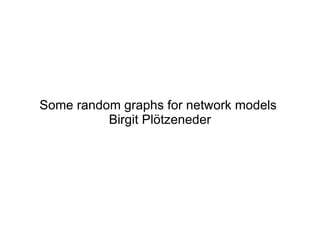Some random graphs for network models - Birgit Plötzeneder
•Download as ODP, PDF•
2 likes•1,404 views
Some algorithms ; useful for studying social networks
Report
Share
Report
Share

Recommended
Recommended
More Related Content
Viewers also liked
Viewers also liked (11)
【Original】Optimization of industrial distribution based on small world networks

【Original】Optimization of industrial distribution based on small world networks
Similar to Some random graphs for network models - Birgit Plötzeneder
Similar to Some random graphs for network models - Birgit Plötzeneder (20)
Social Network Based Information Systems (Tin180 Com)

Social Network Based Information Systems (Tin180 Com)
ICPSR - Complex Systems Models in the Social Sciences - Lecture 3 - Professor...

ICPSR - Complex Systems Models in the Social Sciences - Lecture 3 - Professor...
Community structure in social and biological structures

Community structure in social and biological structures
DISTRIBUTION OF MAXIMAL CLIQUE SIZE UNDER THE WATTS-STROGATZ MODEL OF EVOLUTI...

DISTRIBUTION OF MAXIMAL CLIQUE SIZE UNDER THE WATTS-STROGATZ MODEL OF EVOLUTI...
Steiner Tree: approach applying for shortest path in selected network

Steiner Tree: approach applying for shortest path in selected network
More from Birgit Plötzeneder
More from Birgit Plötzeneder (13)
Recently uploaded
APM Welcome
Tuesday 30 April 2024
APM North West Network Conference, Synergies Across Sectors
Presented by:
Professor Adam Boddison OBE, Chief Executive Officer, APM
Conference overview:
https://www.apm.org.uk/community/apm-north-west-branch-conference/
Content description:
APM welcome from CEO
The main conference objective was to promote the Project Management profession with interaction between project practitioners, APM Corporate members, current project management students, academia and all who have an interest in projects.APM Welcome, APM North West Network Conference, Synergies Across Sectors

APM Welcome, APM North West Network Conference, Synergies Across SectorsAssociation for Project Management
God is a creative God Gen 1:1. All that He created was “good”, could also be translated “beautiful”. God created man in His own image Gen 1:27. Maths helps us discover the beauty that God has created in His world and, in turn, create beautiful designs to serve and enrich the lives of others.
Explore beautiful and ugly buildings. Mathematics helps us create beautiful d...

Explore beautiful and ugly buildings. Mathematics helps us create beautiful d...christianmathematics
This presentation was provided by William Mattingly of the Smithsonian Institution, during the third segment of the NISO training series "AI & Prompt Design." Session Three: Beginning Conversations, was held on April 18, 2024.Mattingly "AI & Prompt Design: The Basics of Prompt Design"

Mattingly "AI & Prompt Design: The Basics of Prompt Design"National Information Standards Organization (NISO)
This presentation was provided by William Mattingly of the Smithsonian Institution, during the fourth segment of the NISO training series "AI & Prompt Design." Session Four: Structured Data and Assistants, was held on April 25, 2024.Mattingly "AI & Prompt Design: Structured Data, Assistants, & RAG"

Mattingly "AI & Prompt Design: Structured Data, Assistants, & RAG"National Information Standards Organization (NISO)
Mehran University Newsletter is a Quarterly Publication from Public Relations OfficeMehran University Newsletter Vol-X, Issue-I, 2024

Mehran University Newsletter Vol-X, Issue-I, 2024Mehran University of Engineering & Technology, Jamshoro
Recently uploaded (20)
APM Welcome, APM North West Network Conference, Synergies Across Sectors

APM Welcome, APM North West Network Conference, Synergies Across Sectors
Explore beautiful and ugly buildings. Mathematics helps us create beautiful d...

Explore beautiful and ugly buildings. Mathematics helps us create beautiful d...
Mattingly "AI & Prompt Design: The Basics of Prompt Design"

Mattingly "AI & Prompt Design: The Basics of Prompt Design"
This PowerPoint helps students to consider the concept of infinity.

This PowerPoint helps students to consider the concept of infinity.
Mixin Classes in Odoo 17 How to Extend Models Using Mixin Classes

Mixin Classes in Odoo 17 How to Extend Models Using Mixin Classes
Z Score,T Score, Percential Rank and Box Plot Graph

Z Score,T Score, Percential Rank and Box Plot Graph
Mattingly "AI & Prompt Design: Structured Data, Assistants, & RAG"

Mattingly "AI & Prompt Design: Structured Data, Assistants, & RAG"
Seal of Good Local Governance (SGLG) 2024Final.pptx

Seal of Good Local Governance (SGLG) 2024Final.pptx
Some random graphs for network models - Birgit Plötzeneder
- 1. Some random graphs for network models Birgit Plötzeneder
- 2. Bell-shaped node degree distributions
- 3. Random model Erdös,Renyi (1960s) On random graphs I; On the evolution of random graphs; On the strength of connectedness of a random grap h - start with N disconnected nodes - connect nodes with probability p to each other
- 4. Watts and Strogatz Watts, Strogatz (1998), Collective dynamics of "small-world" networks - one-dimensional ring lattice of N nodes connected to its 2 K nearest neighbors - goes through each of the edges in turn and, independently with probability p "rewire" it to a randomly selected (different) node
- 5. Watts and Strogatz - average distance grows like O(log(N) and not O(N). - support high levels of clustering „ The small-world effect (short average distance between nodes and high levelsof clustering) has been detected in networks that include a network of actors in Hollywood, the power generator network in the western US...“ Gerardo Chowell and Carlos Castillo-Chavez, Worst-Case Scenarios and Epidemics
- 7. Don't replace edges, instead create shortcuts
- 8. Power-law degree distributions = Pareto distributions
- 9. Pareto distributions - small number of highly connected nodes, most nodes have a small number of connections - Barabasi and Albert called them scale-free networks
- 10. Barabási and Albert Barabàsi, Albert (1999) Emergence of scaling in random networks - starts with a small number of nodes - a new node connects with higher probability to nodes that have already accumulated a higher number of connections
- 12. Klemm, Eguíluz (2002) Growing scale-free networks with small-world behavior
- 14. Dorogovtsev, Mendes, Samukhin Dorogovtsev, Mendes, Samukhin : How to generate a random growing network - with each step, the edges of a growing network are transformed into configurations of edges and new vertices according to some probability function
